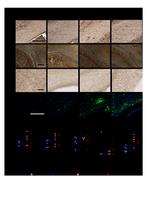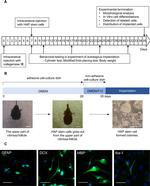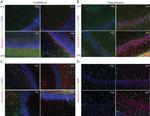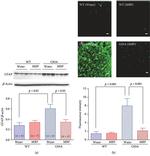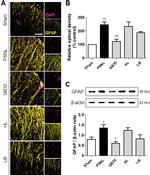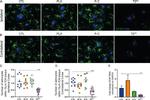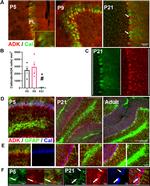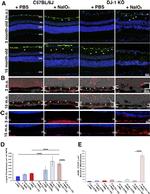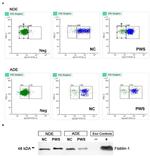Product References
Direct implantation of hair-follicle-associated pluripotent (HAP) stem cells repairs intracerebral hemorrhage and reduces neuroinflammation in mouse model.
PloS one
Obara K,Shirai K,Hamada Y,Arakawa N,Hasegawa A,Takaoka N,Aki R,Hoffman RM,Amoh Y
Published figure using GFAP monoclonal antibody (Product # 42-9892-82) in Immunocytochemistry
Tue Jan 17 00:00:00 EST 2023
Light-sheet mesoscopy with the Mesolens provides fast sub-cellular resolution imaging throughout large tissue volumes.
iScience
Battistella E,Schniete J,Wesencraft K,Quintana JF,McConnell G
Published figure using GFAP monoclonal antibody (Product # 42-9892-82) in Immunohistochemistry
Fri Sep 16 00:00:00 EDT 2022
The spatial transcriptomic landscape of non-small cell lung cancer brain metastasis.
Nature communications
Zhang Q,Abdo R,Iosef C,Kaneko T,Cecchini M,Han VK,Li SS
Published figure using GFAP monoclonal antibody (Product # 42-9892-82) in Immunohistochemistry
Mon Oct 10 00:00:00 EDT 2022
Glial receptor PLXNB2 regulates schizophrenia-related stress perception via the amygdala.
Frontiers in immunology
Xuan FL,Yan L,Li Y,Fan F,Deng H,Gou M,Chithanathan K,Heinla I,Yuan L,Seppa K,Zharkovsky A,Kalda A,Hong LE,Hu GF,Tan Y,Tian L
Published figure using GFAP monoclonal antibody (Product # 42-9892-82) in Immunohistochemistry
Mon Nov 07 00:00:00 EST 2022
Activated microglia mitigate Aβ-associated tau seeding and spreading.
The Journal of experimental medicine
Gratuze M,Chen Y,Parhizkar S,Jain N,Strickland MR,Serrano JR,Colonna M,Ulrich JD,Holtzman DM
Published figure using GFAP monoclonal antibody (Product # 42-9892-82) in Immunohistochemistry
Mon Aug 02 00:00:00 EDT 2021
Regionally diverse astrocyte subtypes and their heterogeneous response to EAE.
Glia
Borggrewe M,Grit C,Vainchtein ID,Brouwer N,Wesseling EM,Laman JD,Eggen BJL,Kooistra SM,Boddeke EWGM
Published figure using GFAP monoclonal antibody (Product # 42-9892-82) in Immunohistochemistry
Sat May 01 00:00:00 EDT 2021
CSF SERPINA3 Levels Are Elevated in Patients With Progressive MS.
Neurology(R) neuroimmunology & neuroinflammation
Fissolo N,Matute-Blanch C,Osman M,Costa C,Pinteac R,Miró B,Sanchez A,Brito V,Dujmovic I,Voortman M,Khalil M,Borràs E,Sabidó E,Issazadeh-Navikas S,Montalban X,Comabella Lopez M
Published figure using GFAP monoclonal antibody (Product # 42-9892-82) in Immunohistochemistry
Mon Mar 01 00:00:00 EST 2021
CSF SERPINA3 Levels Are Elevated in Patients With Progressive MS.
Neurology(R) neuroimmunology & neuroinflammation
Fissolo N,Matute-Blanch C,Osman M,Costa C,Pinteac R,Miró B,Sanchez A,Brito V,Dujmovic I,Voortman M,Khalil M,Borràs E,Sabidó E,Issazadeh-Navikas S,Montalban X,Comabella Lopez M
Published figure using GFAP monoclonal antibody (Product # 42-9892-82) in Immunohistochemistry
Mon Mar 01 00:00:00 EST 2021
Developmental Role of Adenosine Kinase in the Cerebellum.
eNeuro
Gebril H,Wahba A,Zhou X,Lai T,Alharfoush E,DiCicco-Bloom E,Boison D
Published figure using GFAP monoclonal antibody (Product # 42-9892-82) in Immunohistochemistry
Fri Jul 02 00:00:00 EDT 2021
Studies of involvement of G-protein coupled receptor-3 in cannabidiol effects on inflammatory responses of mouse primary astrocytes and microglia.
PloS one
Wu J,Chen N,Liu Y,Godlewski G,Kaplan HJ,Shrader SH,Song ZH,Shao H
Published figure using GFAP monoclonal antibody (Product # 42-9892-82) in Immunohistochemistry
Thu Oct 21 00:00:00 EDT 2021
Bidens pilosa Extract Administered after Symptom Onset Attenuates Glial Activation, Improves Motor Performance, and Prolongs Survival in a Mouse Model of Amyotrophic Lateral Sclerosis.
Oxidative medicine and cellular longevity
Kosuge Y,Kaneko E,Nango H,Miyagishi H,Ishige K,Ito Y
Published figure using GFAP monoclonal antibody (Product # 42-9892-82) in Immunocytochemistry
Thu Sep 17 00:00:00 EDT 2020
Muscovite nanoparticles mitigate neuropathic pain by modulating the inflammatory response and neuroglial activation in the spinal cord.
Neural regeneration research
Oh JY,Hwang TY,Jang JH,Park JY,Ryu Y,Lee H,Park HJ
Published figure using GFAP monoclonal antibody (Product # 42-9892-82) in Immunohistochemistry (Frozen)
Sun Nov 01 00:00:00 EDT 2020
Plasma Levels of Neuron- and Astrocyte-Derived Exosomal Amyloid Beta1-42, Amyloid Beta1-40, and Phosphorylated Tau Levels in Schizophrenia Patients and Non-psychiatric Comparison Subjects: Relationships With Cognitive Functioning and Psychopathology.
Frontiers in psychiatry
Lee EE,Winston-Gray C,Barlow JW,Rissman RA,Jeste DV
Published figure using GFAP monoclonal antibody (Product # 42-9892-82) in Western Blot
Sat Mar 27 00:00:00 EDT 2021
Flow-cytometric microglial sorting coupled with quantitative proteomics identifies moesin as a highly-abundant microglial protein with relevance to Alzheimer's disease.
Molecular neurodegeneration
Rayaprolu S,Gao T,Xiao H,Ramesha S,Weinstock LD,Shah J,Duong DM,Dammer EB,Webster JA,Lah JJ,Wood LB,Betarbet R,Levey AI,Seyfried NT,Rangaraju S
Published figure using GFAP monoclonal antibody (Product # 42-9892-82) in Immunohistochemistry
Thu May 07 00:00:00 EDT 2020
Inhibition of GSK3β and RIP1K Attenuates Glial Scar Formation Induced by Ischemic Stroke via Reduction of Inflammatory Cytokine Production.
Frontiers in pharmacology
Liu J,Zhu YM,Guo Y,Lin L,Wang ZX,Gu F,Dong XY,Zhou M,Wang YF,Zhang HL
Published figure using GFAP monoclonal antibody (Product # 42-9892-82) in Immunocytochemistry
Mon Sep 28 00:00:00 EDT 2020
Inhibition of GSK3β and RIP1K Attenuates Glial Scar Formation Induced by Ischemic Stroke via Reduction of Inflammatory Cytokine Production.
Frontiers in pharmacology
Liu J,Zhu YM,Guo Y,Lin L,Wang ZX,Gu F,Dong XY,Zhou M,Wang YF,Zhang HL
Published figure using GFAP monoclonal antibody (Product # 42-9892-82) in Immunocytochemistry
Mon Sep 28 00:00:00 EDT 2020
Oxidative stress in the retina and retinal pigment epithelium (RPE): Role of aging, and DJ-1.
Redox biology
Upadhyay M,Milliner C,Bell BA,Bonilha VL
Published figure using GFAP monoclonal antibody (Product # 42-9892-82) in Immunohistochemistry
Thu Oct 01 00:00:00 EDT 2020
Neuroprotective effect of ACTH on collagenase-induced peri-intraventricular hemorrhage in newborn male rats.
Scientific reports
Martins CA,Neves LT,de Oliveira MMBP,Bagatini PB,Barboza R,Mestriner RG,Xavier LL,Rasia-Filho AA
Published figure using GFAP monoclonal antibody (Product # 42-9892-82) in Immunocytochemistry
Tue Oct 20 00:00:00 EDT 2020
FGL2 promotes tumor progression in the CNS by suppressing CD103+ dendritic cell differentiation.
Nature communications
Yan J,Zhao Q,Gabrusiewicz K,Kong LY,Xia X,Wang J,Ott M,Xu J,Davis RE,Huo L,Rao G,Sun SC,Watowich SS,Heimberger AB,Li S
Published figure using GFAP monoclonal antibody (Product # 42-9892-82) in Immunofluorescence
Fri Jan 25 00:00:00 EST 2019
CHIMERA repetitive mild traumatic brain injury induces chronic behavioural and neuropathological phenotypes in wild-type and APP/PS1 mice.
Alzheimer's research & therapy
Cheng WH,Martens KM,Bashir A,Cheung H,Stukas S,Gibbs E,Namjoshi DR,Button EB,Wilkinson A,Barron CJ,Cashman NR,Cripton PA,Wellington CL
Published figure using GFAP monoclonal antibody (Product # 42-9892-82) in Immunohistochemistry
Sat Jan 12 00:00:00 EST 2019
Roles of Pannexin-1 Channels in Inflammatory Response through the TLRs/NF-Kappa B Signaling Pathway Following Experimental Subarachnoid Hemorrhage in Rats.
Frontiers in molecular neuroscience
Wu LY,Ye ZN,Zhou CH,Wang CX,Xie GB,Zhang XS,Gao YY,Zhang ZH,Zhou ML,Zhuang Z,Liu JP,Hang CH,Shi JX
Published figure using GFAP monoclonal antibody (Product # 42-9892-82) in Immunofluorescence
Thu Oct 01 00:00:00 EDT 2020
Development of a culture system to induce microglia-like cells from haematopoietic cells.
Neuropathology and applied neurobiology
Noto D,Sakuma H,Takahashi K,Saika R,Saga R,Yamada M,Yamamura T,Miyake S
42-9892 was used in Immunohistochemistry to outline the conditions and factors necessary for the differentiation of microglia from progenitors.
Wed Oct 01 00:00:00 EDT 2014







